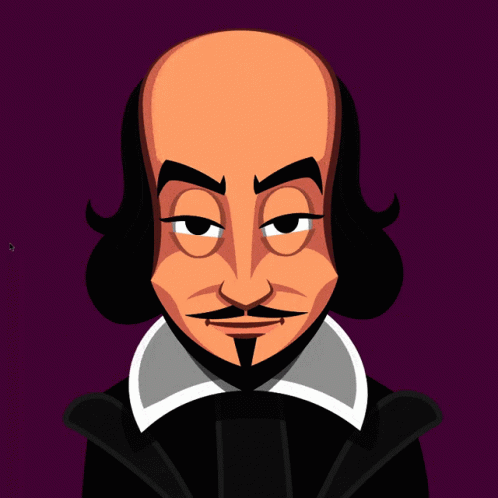
Taken from: https://media.tenor.com/cgWhAFMoHAMAAAAC/william-shakespeare-shakespearesshitstorm.gif
Introduction to the MYP Year 4 IB Language and Literature Course
In the MYP Year 4 International Baccalaureate (IB) Language and Literature course, students embark on an enriching journey that delves deep into the realm of language, literature, and communication. Building upon the foundational knowledge gained in previous years, Year 4 is a pivotal stage where students refine their analytical skills, broaden their cultural understanding, and further develop their capacity to engage critically with a diverse range of texts. Through this course, students not only enhance their linguistic prowess but also cultivate a profound appreciation for the nuanced art of storytelling and expression.
General Objective
The overarching objective of the MYP Year 4 Language and Literature course is to empower students to become proficient communicators, astute interpreters, and reflective thinkers. By exploring a variety of literary and non-literary texts, students hone their ability to analyze complex ideas, evaluate different perspectives, and articulate their thoughts coherently. Moreover, the course aims to nurture an awareness of language's cultural implications and its potential to influence the world around us.
Methodology
The methodology employed in the MYP Year 4 Language and Literature course is designed to provide students with a holistic and immersive learning experience. Core methodologies include:
-
Textual Analysis: Students engage in in-depth analyses of literary works, scrutinizing themes, literary techniques, and cultural contexts. This fosters critical thinking skills and a deeper understanding of the interplay between language and meaning.
-
Socratic Discussions: Collaborative and inquiry-based discussions encourage students to articulate their interpretations, challenge assumptions, and explore diverse viewpoints. These discussions cultivate effective communication and empathy.
-
Comparative Study: By juxtaposing different texts, genres, and cultural perspectives, students develop a nuanced understanding of the complexities inherent in language and literature. This promotes cross-cultural awareness and intellectual flexibility.
-
Creative Responses: Students are encouraged to respond to texts creatively, whether through writing, multimedia projects, or dramatic interpretations. This nurtures self-expression and allows students to engage actively with the material.
-
Cultural Context Exploration: The course often explores texts from various cultural backgrounds, fostering an appreciation for global literary traditions and sensitizing students to the nuances of language use in different contexts.
-
Research and Inquiry: Students learn to conduct independent research on language-related topics, fostering an inquiry-based approach to learning. This cultivates research skills and encourages curiosity-driven exploration.
Assessment
Assessment in the MYP Year 4 Language and Literature course is multifaceted and designed to evaluate students' comprehensive understanding and skills. It includes:
-
Formative Assessment: Ongoing assessments, such as class discussions, reflections, and group activities, gauge students' engagement, understanding, and collaboration.
-
Summative Assessment: Formal assessments, including essays, presentations, and examinations, assess students' critical analysis, communication, and synthesis of concepts.
Content and Criteria
The course content encompasses a wide spectrum of texts, including classic and contemporary literature, media articles, visual texts, and more.
- What does courage look like?
What
is drama?
How can growing and learning be portrayed in short stories?
- Should we always believe what we see and hear?
- How can poetry be used for protests?
The assessment criteria are distributed as follows:
What is drama?
How can growing and learning be portrayed in short stories?
1. Criterion A: Analyzing: 25%
i. identify and explain the content, context, language, structure, technique and style of text(s) and the relationship among texts
ii. identify and explain the effects of the creator’s choices on an audience
iii. justify opinions and ideas, using examples, explanations and terminology
iv. interpret similarities and differences in features within and between genres and texts
2. Criterion B: Organizing: 25%
i. employ organizational structures that serve the context and intention
ii. organize opinions and ideas in a coherent and logical manner
iii. use referencing and formatting tools to create a presentation style suitable to the context and intention.
3. Criterion C: Producing Texts: 25%
i. produce texts that demonstrate thought, imagination and sensitivity, while exploring and considering
new perspectives and ideas arising from personal engagement with the creative process
ii. make stylistic choices in terms of linguistic, literary and visual devices, demonstrating awareness of
impact on an audience
iii. select relevant details and examples to develop ideas.
4. Criterion D: Using Language: 25%
i. use appropriate and varied vocabulary, sentence structures and forms of expression
ii. write and speak in an appropriate register and style
iii. use correct grammar, syntax and punctuation
iv. spell (alphabetic languages), write (character languages) and pronounce with accuracy
v. use appropriate non-verbal communication technique
s

- Profesor: Angela Guiovana Gordon Naranjo
- Profesor: Angeles Jaramillo Cardona